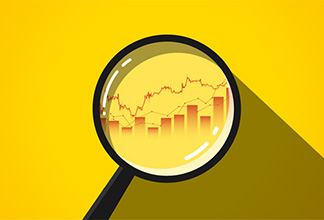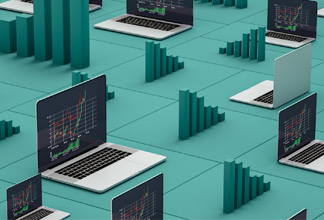Why Should Investors Care About Bond Yields?
Written by The Inspired Investor Team | Published on April 28, 2021
Written by The Inspired Investor Team | Published on April 28, 2021
From time to time, bond yields make headlines in the financial press, either because they're going up or because they're going down. Even if you don't own any bonds, it's often wise to pay attention to changes in bond yields. Why? Bond yields can offer hints about where the economy may be headed.
A quick refresher on bonds: When a government or company needs to borrow large sums of money, it issues bonds. Investors buy the bonds, and in return, the issuer promises to pay an annual interest rate (the coupon rate) on the loan, usually in payments every six months. The issuer generally also promises to repay the principal value of the bond (also called face value or par value) on a specific maturity date.
Bonds are a type of fixed-income product. They can generate a predictable stream of interest income and/or promise a future lump-sum payment. Bonds are typically viewed as having less risk than stocks. One key consideration for holding bonds and other fixed-income products in a portfolio is that they can help offset negative returns on other asset classes, helping to reduce overall volatility. (Learn more in Understanding Fixed Income.)
Bond prices and bond yields
A bond price is what an investor pays for a bond. A bond yield is a general term used to describe the return an investor can expect to receive from an investment in a bond. There are a few different types of yields, but a common one you'll see in a quote is Yield to Maturity. Technically, it's based on the bond being held until maturity and the coupon payments reinvested at the yield to maturity interest rate.
Bond prices and yields fluctuate daily, even though a bond's face value, interest rate and maturity are typically fixed. How is that possible? After bonds are issued, investors trade them on the secondary bond market. (The primary market is where securities are created and initially issued; the secondary market is where investors buy or sell previously issued securities.)
Many factors affect bond prices and yields, including inflation, interest rates and investor demand. The key thing to know is that bond prices and bond yields have an inverse relationship, meaning that they move in opposite directions. When a bond's price increases, its yield decreases; when its price decreases, its yield increases. Here's an example:
Why would someone pay more than face value? Because a bond's interest rate is higher than what the market comparatively offers, or the credit rating of a bond or its issuer makes it an attractive investment.
Even if you don't own bonds and are not planning to buy any, bond yields can give you clues about what's going on in the markets. When bond yields are falling and bond prices are rising, it could indicate an increase in demand for "safe" investments. Investors typically favour bonds when they're looking for a safe place to put their money. If bond yields are rising, that signals bond holders are selling bonds and likely moving money back into the stock market – a sign of optimism for the economy.
Did you know? When it comes to tracking bond yields, all eyes are on the 10-year U.S. Treasury Note, one of the types of bonds that the U.S. Department of the Treasury issues to finance government spending. Learn more here. |
The impact of inflation
While bonds are less risky than stocks, they do have risks. One is default risk, which refers to the possibility the issuer of the bond may not be able to make its principal and interest payments. Investors can get an idea of default risk by looking at the issuer's rating (learn more in Types of Fixed Income). Another risk is inflation, which affects bonds in two ways:
Various asset classes, including fixed income, can play important roles in an investment portfolio. Diversification can help investors protect their portfolios and manage investment risk with a carefully considered asset mix that suits their investment goals and time horizon.
Learn more about inflation.
RBC Direct Investing Inc. and Royal Bank of Canada are separate corporate entities which are affiliated. RBC Direct Investing Inc. is a wholly owned subsidiary of Royal Bank of Canada and is a Member of the Canadian Investment Regulatory Organization and the Canadian Investor Protection Fund. Royal Bank of Canada and certain of its issuers are related to RBC Direct Investing Inc. RBC Direct Investing Inc. does not provide investment advice or recommendations regarding the purchase or sale of any securities. Investors are responsible for their own investment decisions. RBC Direct Investing is a business name used by RBC Direct Investing Inc. ® / ™ Trademark(s) of Royal Bank of Canada. RBC and Royal Bank are registered trademarks of Royal Bank of Canada. Used under licence.
© Royal Bank of Canada 2025.
Any information, opinions or views provided in this document, including hyperlinks to the RBC Direct Investing Inc. website or the websites of its affiliates or third parties, are for your general information only, and are not intended to provide legal, investment, financial, accounting, tax or other professional advice. While information presented is believed to be factual and current, its accuracy is not guaranteed and it should not be regarded as a complete analysis of the subjects discussed. All expressions of opinion reflect the judgment of the author(s) as of the date of publication and are subject to change. No endorsement of any third parties or their advice, opinions, information, products or services is expressly given or implied by RBC Direct Investing Inc. or its affiliates. You should consult with your advisor before taking any action based upon the information contained in this document.
Furthermore, the products, services and securities referred to in this publication are only available in Canada and other jurisdictions where they may be legally offered for sale. Information available on the RBC Direct Investing website is intended for access by residents of Canada only, and should not be accessed from any jurisdiction outside Canada.

Here’s what we saw on the trading floor in March 2025

Making these projections might seem like a black art, but there’s science behind it too

Here’s what we saw on the trading floor in January 2025